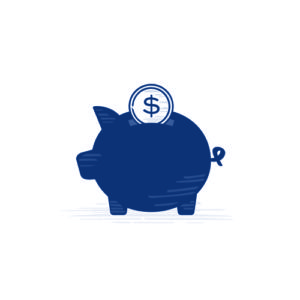Picking Up Pennies – Volume 5

Welcome to the fifth installment of picking up pennies. Last month, we discussed how we trade ETFs by putting our trades in competition to improve the price we buy and sell ETFs for. Although we minimize trading costs, it still costs money to trade. Thus, we want to minimize how often we trade. We only want to trade when it is economically meaningful. This month, we will discuss how we minimize trading by selecting the ETFs we invest in and how we reinvest dividends.
- Volume 1 – Keep Cash Balances Low (Better Chance for Higher Returns)
- Volume 2 – Asset Location (Reduces Taxes)
- Volume 3 – Using ETFs (Reduces Taxes)
- Volume 4 – Trading ETFs in Competition (Reduces Trading Costs)
- Volume 5 – Number of Funds and Not Auto-Reinvesting Dividends (Reduces Trading Costs)
- Volume 6 – Tax Lots and Tax Loss Harvesting (Reduces Taxes)
- Volume 7 – Summary (Total Impact)
ETFs We Use
The US investment universe has over 3,000 different investment companies. To help investors simplify and organize this vast universe, we generally split stocks into four categories: large, small, growth, and value.
Investment advisors will want to ensure they have some allocation to each of these four asset classes. They will try to find “the best” manager in each category. We could take a similar approach and find the best evidence-based fund in each category, but we take a more nuanced approach.
The world, and the publicly traded companies in it, is not a static place. Stocks often change which category they are in. For example, a small-value company may have significant success with a new product and quickly become a large-growth company. When this happens, a small-value fund, if it follows the fund’s Investment Policy Statement promised to investors, would need to sell that stock, and a large-growth fund would need to buy that stock. Thus, if we were like many investors, the two funds we own in aggregate would buy and sell the same stock and incur trading costs. Is that helpful? No!
This is why HIG uses market-wide solutions in our client portfolios. We use one fund that buys stocks in all four categories. This is beneficial for multiple reasons.
First, the ETF won’t buy and sell the same stock as it moves among various categories. On average, funds that only invest in one category have an annual turnover of around 25%, meaning that fully one-quarter of the holdings held on January 1 are sold by December 31 of that year. A market-wide fund has only about 5% turnover per year. Therefore, by investing in one fund instead of four, we cut the amount of trading down by 80% with the same net economic exposure. The same securities are held with less trading costs.
Second, a market-wide fund reduces the need to rebalance the portfolio. Ultimately, we want to invest a certain amount of money in each category. The all-in-one ETF maintains those percentages without the need for additional turnover. However, if you use four funds individually, those amounts will shift over time. You may want 25% in each category, but due to performance differences, you may end up with 35% in one category and 15% in another. Over time, you must sell one fund and buy another to get them back in balance. This will result in trading costs and incur capital gains, increasing your tax bill.
On the face of it, using more funds sounds better than using fewer funds. However, less is more when you invest in the correct funds and understand the details. Less trading, fewer taxes, and more money in your pocket.
Reinvesting Dividends
Another way we save on trading is how we handle dividends. Every investment (ETFs, Mutual Funds, Stocks) produces dividends. Dividends are simply cash paid to an investor and represent a portion of the return you earn on any investment. Most advisors and investors elect to reinvest the dividends automatically. This means if you own ETF ABC, and it pays a $10 dividend, you will automatically turn around and buy $10 more of ABC. This is an easy way for investors to “set it and forget it.” However, this approach, although easy, is not optimal for investors. Why?
First, when you reinvest dividends, you need to go to the market and buy more shares of the ETF. The custodians that automatically reinvest dividends do not care about execution prices. They want to get the cash spent. They usually execute these trades early the following morning when spreads and trading costs are highest. As we talked about last month, trading ETFs can be costly when you don’t put them in competition. Thus, automatically reinvesting dividends usually results in higher trading costs.
Second, we want to invest the extra cash in the asset class that you are underweight. Not the asset class that just paid you money. We want to examine your overall portfolio and determine if you need more stock, fixed income, or US or international exposure. By constantly investing the dividends in the most underweight asset class, we reduce the rebalancing needed in the portfolio over time. This reduces trading costs and taxes. Yes, it means that every quarter, when every ETF pays a dividend, we must go into every account and spend that cash. We do it because this approach improves investor outcomes with better trade execution and lower taxes over time.
This information is educational and does not intend to make an offer for the sale of any specific securities, investments, or strategies. Investments involve risk and, past performance is not indicative of future performance. Return will be reduced by advisory fees and any other expenses incurred in the management of a client’s account. Consult with a qualified financial adviser before implementing any investment strategy.


